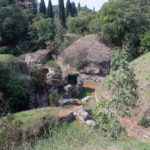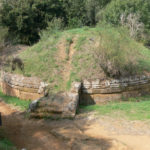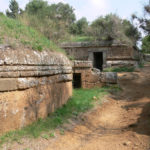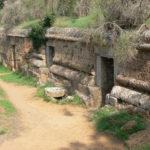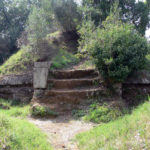An exceptional testimony to the civilization of the Etruscans, the Necropolis of the Banditaccia developed from the 9th century BCE, and expanded from the 7th century BCE onwards.
Thousands of tombs exist within the cemetery, the organization which are replica to Etruscan town planning schemes. They are organized in a city-like plan, with ‘neighborhoods’ and ‘streets’. Furthermore, the frescoed tombs, many of which are replicas of Etruscan houses, offer a unique insight into the daily life of the Etruscans, moreover, pre-Roman Italy.
The Necropolis of the Banditaccia contains many differing types of tombs, such as those carved into rock, in the shape of houses or huts, trenches cut in rock, and tumuli. Such tombs provide us with the only surviving evidence of Etruscan residential architecture. The different types of tombs depend on family status, period, as well as other criteria. The earliest known tombs within the site are a series of rock-cut trenches with pottery ossuaries containing the ashes of the dead.
The most famous of these tombs are the tumuli, which are under an imposing mound (such as shown in photo 2); a well known example of this at Cerveteri is the 4th century ‘Hut Shaped Tomb’. My personal favourite feature of this tomb is the stone couches next to the walls; this tomb, like many others in the archaeological site, imitate houses, and therefore provide to us the best (and only) evidence of Etruscan residential architecture. Other famous examples of tombs within the necropolis include the 6th century BCE ‘Tomb of the Greek Vases’, the ‘Tomb of the Moulding’, and the ‘Tomb of the Capitals’. Perhaps the most famous of the thousands of the Banditaccia tombs is the ‘Tomb of Reliefs’. The Toledo Museum of Art provides a virtual tour inside this tomb if you’re interested in seeing what it looks like.
+Also worth noting: one of the most famous pieces of Etruscan art was discovered at this site, the “Sarcophagus of the Spouses”, currently housed at the Louvre.
Photos courtesy & taken by Roger Ulrich. When writing up this post, the UNESCO World Heritage entry for the site was of great use.

